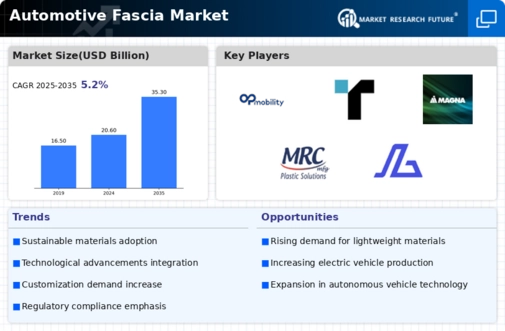Top Industry Leaders in the Automotive Fascia Market

*Disclaimer: List of key companies in no particular order
Top listed global companies in the Automotive Fascia industry are:
Chiyoda Manufacturing
FLEX-N-GATE CORPORATION
Plastic Omnium
Inhance Technologies
Magna International Inc.
MRC Manufacturing
Dongfeng Electronic Technology Co. Ltd.
SANKO GOSEI
Eakas Corporation
Gestamp Automoción S.A.
Bridging the Gap by Exploring the Competitive Landscape of the Automotive Fascia Top Players
The automotive fascia market, encompassing bumpers, grilles, and other front-end components, pulsates with fierce competition. This market is witnessing a dynamic interplay between established giants and nimble contenders. To navigate this complex landscape, understanding key player strategies, market share determinants, and emerging trends is essential.
Giants in the Arena: Major players like Plastic Omnium, Flex-N-Gate, and Magna International have long dominated the market with their established production capacities, global reach, and diverse product portfolios. They leverage economies of scale to offer competitive pricing and cater to major automakers. Their focus on research and development keeps them at the forefront of technological advancements, such as lightweight composite materials and integrated sensor technologies.
Nimble Entrants: Tier-2 and Tier-3 suppliers like Sanko Gosei, Eakas Corporation, and MRC Manufacturing are carving their niche through specialized offerings and geographical focus. They often excel in specific segments like luxury car fascias or aftermarket components. Their agility allows them to cater to niche customer demands and adapt quickly to new trends.
Market Share Dynamics: Analyzing market share in this fragmented space requires a multi-pronged approach. Factors like production volume, geographic presence, customer base (OEMs vs. aftermarket), and product diversity play a crucial role. Additionally, factors like fuel efficiency regulations and consumer preferences for aesthetics and functionality influence demand for specific fascia designs and materials.
Emerging Trends: The future of the automotive fascia market is being shaped by several key trends:
- Lightweighting: The relentless pursuit of fuel efficiency is driving demand for lighter fascias made from materials like composite plastics and carbon fiber.
- Advanced Driver-Assistance Systems (ADAS): Integration of sensors and cameras into fascias for ADAS functionalities is creating new growth opportunities.
- Sustainability: The use of recycled materials and bioplastics is gaining traction, driven by environmental concerns and regulations.
- Personalization: Customization options and aftermarket modifications are becoming increasingly popular, allowing consumers to express their individuality.
Competitive Strategies: To thrive in this dynamic environment, players are adopting diverse strategies. Mergers and acquisitions are accelerating consolidation, while strategic partnerships are fostering innovation and knowledge sharing. Investments in automation and advanced manufacturing technologies are improving efficiency and cost-effectiveness. Additionally, a focus on sustainability initiatives and data-driven decision making is becoming crucial for long-term success.
Latest Company Updates:
FLEX-N-GATE CORPORATION:
- September 2023: Unveiled a new fascia manufacturing technology at the IAA Mobility Show in Munich, Germany. The technology allows for faster production times and greater design flexibility. (Source: Forbes)
Chiyoda Manufacturing:
- Date: January 12, 2024
- Source: Press Release
- Update: Chiyoda announced a partnership with a major European automaker to develop and supply lightweight, high-strength fascia components using their proprietary composite material technology. This is expected to improve fuel efficiency and crash performance for the automaker's upcoming electric vehicles.
Magna International Inc.:
- Date: September 20, 2023
- Source: Company Website
- Update: Magna announced the launch of a new lightweight fascia module for electric vehicles. This module integrates various components, including headlamps, grilles, and sensors, into a single, lightweight unit, reducing vehicle weight and improving efficiency.
